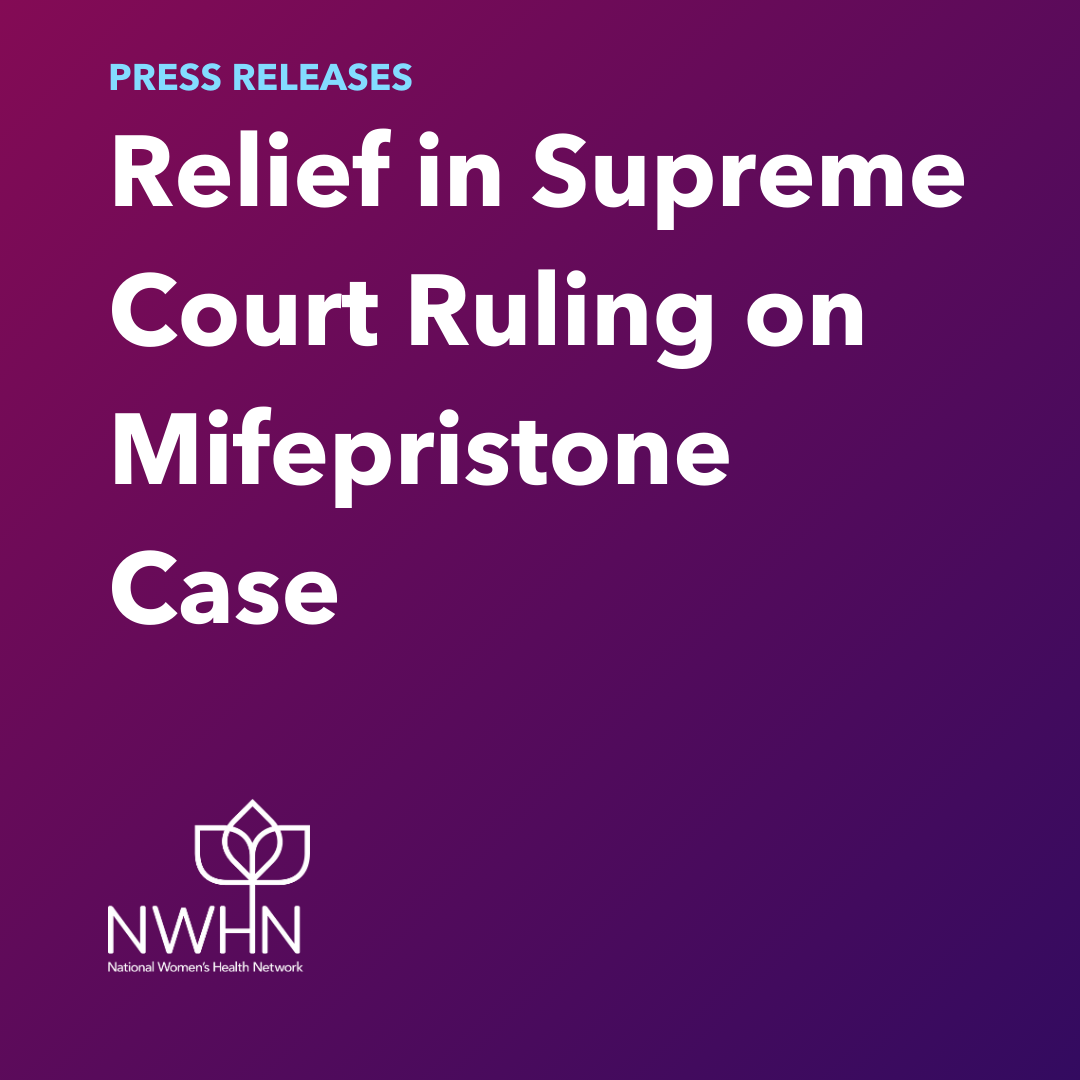FAQs
When Can the Abortion Pill Be Used?
FDA guidance states that medication abortion can be used to end a pregnancy up to 10 weeks from the first day of your last period.
Can I Still Get Pregnant Later? YES
Medication abortion does not increase your future risk of infertility or miscarriage.
Is the Abortion Pill the Same as the Morning After Pill? NO
The morning-after pill is a form of emergency contraception (aka birth control) taken within 5 days of unprotected sex (depending on the regimen/type), or when failure of birth control is a concern, in order to prevent a pregnancy. If you are already pregnant, emergency contraception will NOT induce an abortion.
I Don’t Want to Go to a Clinic. What Are My Options?
Some pregnant people choose to use abortion pills by connecting with a trusted medical care provider via internet, phone, or telemedicine*. Others choose to self-manage their abortion at home using FDA-approved abortion pills which they can discretely order online and have mailed to their home. The NWHN strongly supports the right of individuals to make these choices for themselves.Information on how to access and use abortion pills in the US without going into a clinic:
*Legal restrictions may apply in your state.
Additional Information:
What Is Medication Abortion?
The two most common methods of safely and effectively ending a pregnancy are in-clinic abortions and abortions with FDA-approved pills, also known as medication abortion.
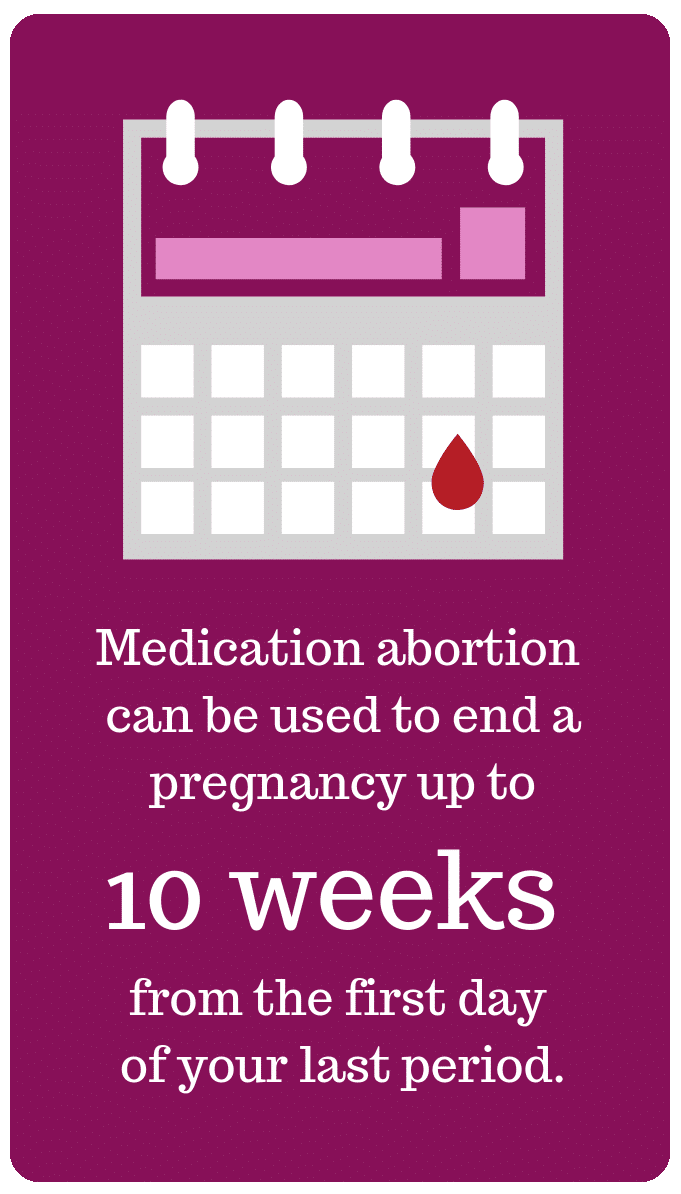 During a medication abortion, the pregnant person induces a miscarriage using FDA-approved medications at home.
During a medication abortion, the pregnant person induces a miscarriage using FDA-approved medications at home.
In-clinic/surgical abortion is an option (and sometimes required) if medication abortion is incomplete. During an in-clinic abortion (sometimes called a “surgical abortion”), a medical professional physically removes the contents of the uterus.
Medication abortion is FDA-approved to end a pregnancy up to 10 weeks from the first day of your last period. The most effective process involves taking two different FDA-approved medications: mifepristone and misoprostol.
Mifepristone:
- Originally called RU-486; brand names include Mifeprex and Mifegyne, among others
- First developed in France in 1980 and approved for use in Europe throughout the 1990s
- Approved by the FDA for use in the United States in 2000 and now legally prescribed in 60+ countries
- Safely used in combination with misoprostol over 3.7 million times in the U.S. since its approval
- Safer than many over-the-counter medicines currently sold in the US without a prescription
- Typically only available in the US through health clinics and hospitals instead of through US-based pharmacies, due to political restrictions
- Can be obtained without a prescription through many online pharmacies
Misoprostol:
- Brand names include Cytotec and Misodel, among others
- First developed in 1973 to treat stomach ulcers
- Available in US-based pharmacies with a prescription and often sold over the counter without a prescription outside of the US
How Does Medication Abortion Work?
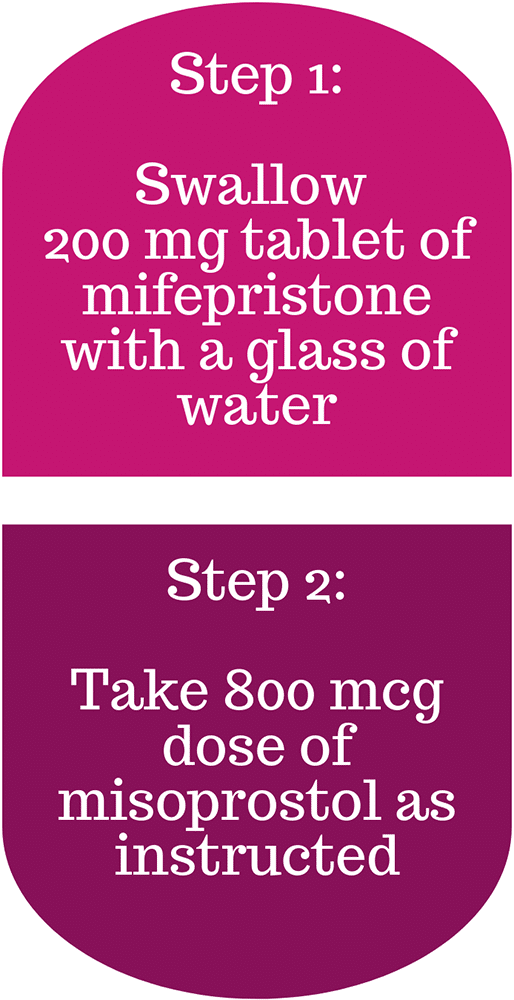 Step 1:
Step 1:
Swallow a 200 mg tablet of mifepristone with a glass of water to block the hormone progesterone which helps line the uterus during pregnancy.
Step 2:
Up to 48 hours later (1-2 days), take an 800 mcg dose of misoprostol (often four 200 mcg tablets) to increase uterine contractions in order to empty the contents of the uterus. Be sure to follow the instructions carefully. Misoprostol is most often taken by dissolving the pills under your cheek or tongue or by inserting them into your vagina, not by swallowing them.
The two medications are recommended by the World Health Organization and The American College of Obstetricians and Gynecologists (ACOG) and are up to 99.7% effective when taken together this way. Alternatively, a pregnant person may only take misoprostol, following a different dose and schedule. (Misoprostol alone is up to 85-90% effective.)
How Safe Is Medication Abortion?
Medication abortion is so safe that it could be sold over-the-counter (OTC) without a prescription if not for political considerations.
 Fewer than 4 people out of 1,000 will have serious complications requiring hospitalization, infusion, or surgery. Out of more than 3.7 million medication abortions administered in the U.S. since 2000, only 13 deaths from causes “probably or possibly related to” medication abortion have ever been reported to the FDA.
Fewer than 4 people out of 1,000 will have serious complications requiring hospitalization, infusion, or surgery. Out of more than 3.7 million medication abortions administered in the U.S. since 2000, only 13 deaths from causes “probably or possibly related to” medication abortion have ever been reported to the FDA.
To put those numbers in perspective, commonly prescribed drugs for erectile dysfunction, like Viagra, are six times deadlier, with a mortality rate of 4 deaths per 100,000 users. Meanwhile, more than 600 people die each year from acute liver failure caused by acetaminophen (Tylenol) overdose and another 16,500 die from serious gastrointestinal bleeding caused by nonsteroidal anti-inflammatory drugs (NSAIDs)-the category that includes brand names such as Motrin, Advil, and Aleve.
And, of course, medication abortion is much safer than pregnancy or childbirth. According to the U.S. Centers for Disease Control and Prevention (CDC), there are 17.3 pregnancy-related deaths in the U.S. for 100,000 live births. The numbers are significantly worse for Non-Hispanic Black women (41.4 deaths per 100,000 live births)and Non-Hispanic American Indian or Alaska Native women (26.5 deaths per 100,000 live births). These women are also the most likely to face economic, geographic, and political barriers to accessing abortion care when they need it.
How Does Medication Abortion Differ From Spontaneous Miscarriage?
FDA-approved abortion pills work by inducing a miscarriage.
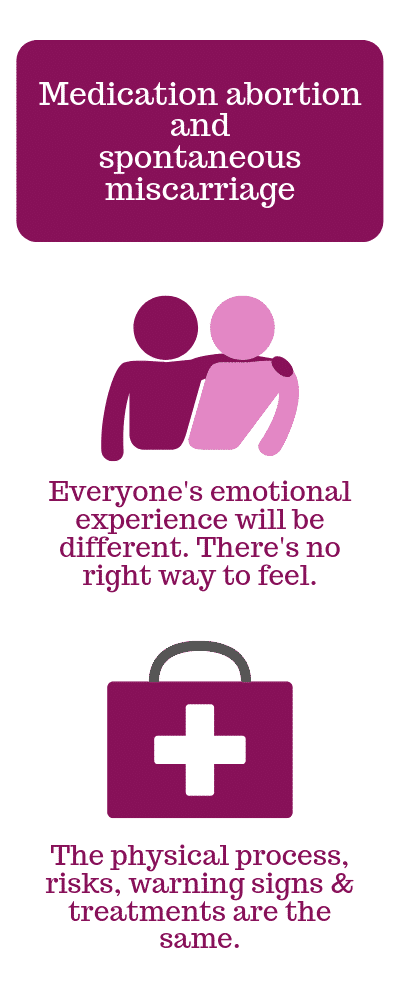 The emotional experiences of a medication abortion and a spontaneously occurring miscarriage may be very different. Everyone will experience the process differently and that’s okay. There’s no right or wrong way to feel!
The emotional experiences of a medication abortion and a spontaneously occurring miscarriage may be very different. Everyone will experience the process differently and that’s okay. There’s no right or wrong way to feel!
From a medical perspective, there is no physically significant difference between a medication abortion and a spontaneously occurring miscarriage. The physical process, risks, warning signs, potential complications, and treatments are the same. For example, the medicines used in medication abortion are used to help safely manage an incomplete miscarriage.
That’s important to know because it means:
- Medication abortion simply initiates the body’s same natural process for when an early pregnancy ends. As many as 1 out of 5 known pregnancies ends in a spontaneously occurring miscarriage, most caused by chromosomal abnormalities that happen by chance during early embryonic development. Whether a miscarriage occurs spontaneously or is induced with FDA-approved abortion pills, it usually resolves safely without medical intervention, and serious complications are rare.
- There is no test to determine if you have taken abortion pills. If you aren’t comfortable telling a medical provider that you’ve had a medication abortion instead of a spontaneous miscarriage, it is not necessary to do so. Your body won’t give you away. (One note of caution: it can take four days for vaginally administered misoprostol tablets to dissolve completely. If you’re not comfortable discussing your abortion with your doctor, you may need to remove any undissolved tablets before a pelvic exam.)
- In states or religiously affiliated hospital systems that are hostile to abortion rights, people with spontaneously occurring miscarriages may still face harassment even if they didn’t take steps to end their pregnancies.
Is the Abortion Pill the Same as the Morning After Pill? No!
The morning-after pill is a form of emergency contraception (aka birth control) taken within a few days of unprotected sex in order to prevent a pregnancy. If you are already pregnant, emergency contraception will NOT induce an abortion.
Some forms of emergency contraception, like levonorgestrel (brand name Plan B) can purchased over the counter or through sites like Amazon and Walmart.com. Other forms, like ulipristal acetate (brand name Ella) are available by prescription. The copper IUD (placed in the uterus by a medical professional) can also be used as emergency birth control if inserted within 5 days of sex.
What if I Take the First Medicine (Mifepristone) but Not the Second One (Misoprostol)?
You might have a complete abortion, you might have a missed abortion in which the fetus is no longer viable but remains in your uterus, or your pregnancy might continue. There is no evidence that an abortion can be “reversed” through techniques like dosing with progesterone, and we don’t know how risky such techniques might be for the pregnant person.
What Should I Expect?
Symptoms vary from person to person and depend on various factors, including how far along a pregnancy is.
Each body is unique, and no two experiences are the same. The end of an early pregnancy can be taxing physically and sometimes mentally. Take steps to make your process as comfortable as possible. If something feels wrong, contact a health professional right away.
- You will experience bleeding or spotting that can last for several days and may be like a heavy period or may be significantly darker and heavier. The further along a pregnancy, the heavier the bleeding will likely be. You may also experience light bleeding for several weeks afterward.
- You will feel cramping (uterine contractions) and abdominal pain within a few hours of taking misoprostol as your body works to expel tissue from the uterus. Again, the further along your pregnancy is, the more intense your cramps and bleeding are likely to be. If you can, plan to spend one or more days at home or wherever you’ll be most comfortable. For most people, standard over-the-counter pain relievers like Tylenol (acetaminophen) or Advil (ibuprofen) are enough to provide relief. (Avoid aspirin, which can make you bleed more.) But if you are in a lot of pain and your favorite go-to cramp reliever isn’t helping, contact your health care provider.
- Common Symptoms: You may have nausea (43-66%), vomiting (23-40%), diarrhea (23-35%), headache (13-40%), dizziness (28-39%), and fever (lower than 100.4° F), warmth, hot flushes, or chills (32-69%).
- However, you should contact a health care provider immediately if you experience any of the following symptoms: have no bleeding within 24 hours after taking Misoprostol; soak through more than 2 maxi pads in an hour for 2+ hours in a row; pass large clots (larger than a lemon) for more than 2 hours; have pain (belly or cramps) that doesn’t get better with pain medication; have a fever of ≥100.4° F for more than 24 hours after taking Misoprostol; or have nausea, vomiting, diarrhea, and/or weakness that extends beyond 24 hours after taking Misoprostol.
- You may see blood clots or tissue that looks gray. Passing tissue is nothing to be concerned about; the tissue itself can be flushed safely.
- Your cervix will soften to allow tissue to leave your uterus more easily so avoid putting anything into your vagina-including tampons, menstrual cups, fingers, sex toys, penises, anything!-for up to 2 weeks to help prevent infection.
- Your pregnancy hormone hCG will go back to normal 4 – 6 weeks after an abortion and your pregnancy symptoms-such as morning sickness and breast tenderness-will fade with it. Typically, the further along the pregnancy was, the longer it will take for hCG to disappear. Wait at least 3 weeks after an abortion before taking a pregnancy test to avoid a false positive.
- Your first menstrual cycle will return in 4 – 8 weeks and could be heavier than your previous ones, as your body is still trying to expel thicker uterine lining. Elevated levels of hCG and other hormones may alter the timing and length of your period.
- You could ovulate within 1 – 2 weeks after an early pregnancy ends-before your period returns! Medication abortion does not impact your ability to become pregnant again. So take precautions when having vaginal-penile sex.
Where Can I Get Assistance?
Whether a miscarriage occurs spontaneously or is induced with FDA-approved abortion pills, it usually resolves safely without medical intervention, and serious complications are rare.
- You should contact a health care provider immediately if you experience any of the following symptoms:
- Have no bleeding within 24 hours after taking Misoprostol
- Soak through more than 2 maxi pads in an hour for 2+ hours in a row
- Pass large clots (larger than a lemon) for more than 2 hours; have pain (belly or cramps) that doesn’t get better with pain medication
- Have a fever of ≥100.4° F for more than 24 hours after taking Misoprostol
- Have nausea, vomiting, diarrhea, and/or weakness that extends beyond 24 hours after taking Misoprostol.
Treatment
There are typically two options to remove any remaining tissue from the uterus and prevent infection:
- Medication to help the body eliminate the remaining contents of the uterus on its own (for instance, your doctor may prescribe additional Misoprostol pills, the second step in a medication abortion) or
- A procedure to physically remove the contents of the uterus through suction abortion/vacuum aspiration, sometimes referred to as dilation and curettage (D&C).
Both medication and physical removal are completely safe, and the choice between the two is usually up to the individual.
When seeking medical care for either an incomplete miscarriage or abortion, it is not necessary to tell medical personnel whether you have had an abortion or a miscarriage. Trusted resource Women on Web notes, “there are no tests that can show that a pregnant person has done a medication abortion,” and “any clinic that can deal with complications of miscarriage can also help women with incomplete abortions, because the symptoms are the same.”
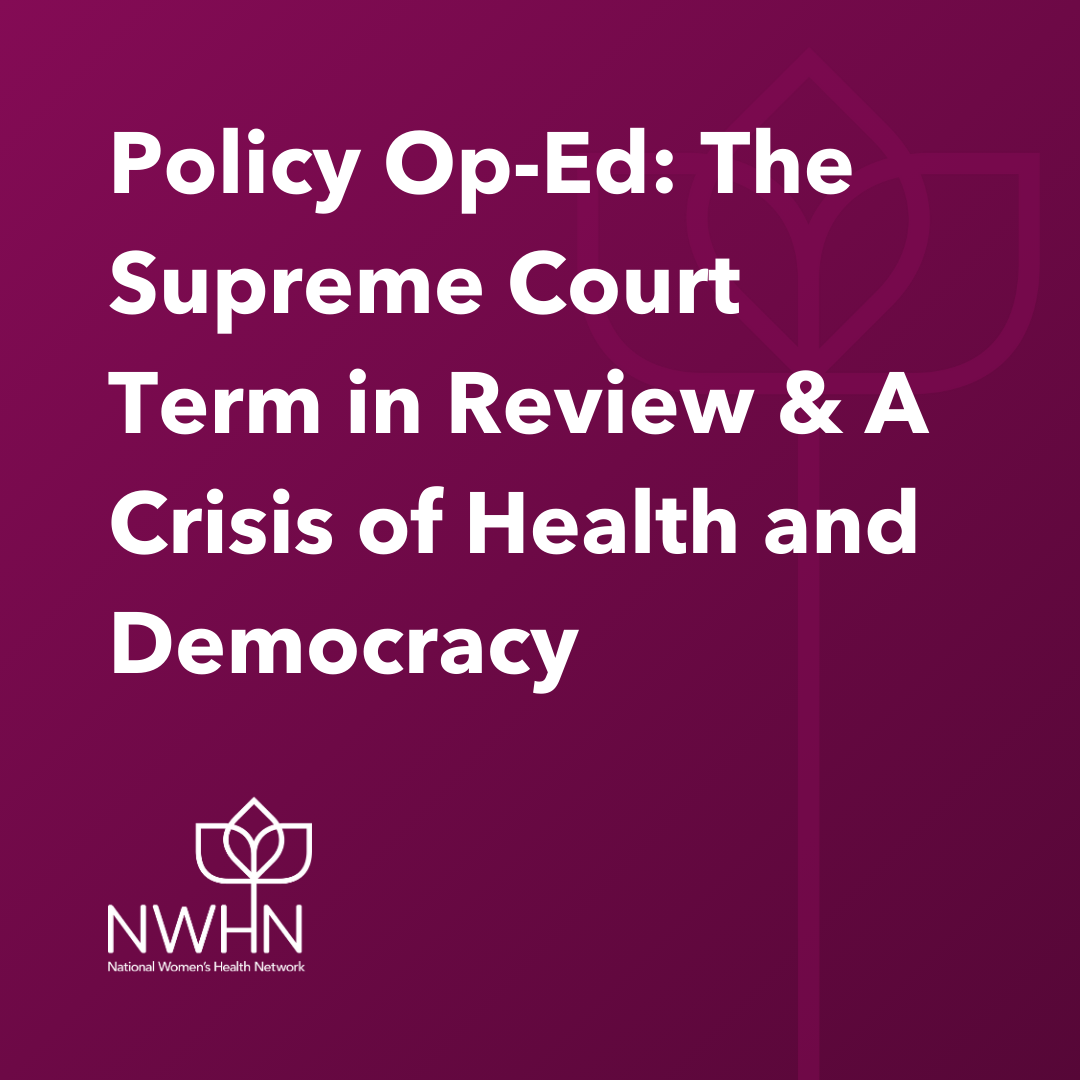
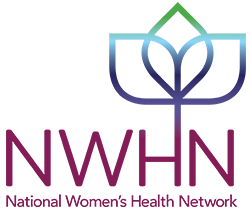


 During a medication abortion, the pregnant person induces a miscarriage using FDA-approved medications at home.
During a medication abortion, the pregnant person induces a miscarriage using FDA-approved medications at home. Step 1:
Step 1: Fewer than 4 people out of 1,000 will have serious complications requiring hospitalization, infusion, or surgery. Out of more than 3.7 million medication abortions administered in the U.S. since 2000, only 13 deaths from causes “probably or possibly related to” medication abortion
Fewer than 4 people out of 1,000 will have serious complications requiring hospitalization, infusion, or surgery. Out of more than 3.7 million medication abortions administered in the U.S. since 2000, only 13 deaths from causes “probably or possibly related to” medication abortion  The emotional experiences of a medication abortion and a spontaneously occurring miscarriage may be very different. Everyone will experience the process differently and that’s okay. There’s no right or wrong way to feel!
The emotional experiences of a medication abortion and a spontaneously occurring miscarriage may be very different. Everyone will experience the process differently and that’s okay. There’s no right or wrong way to feel!


